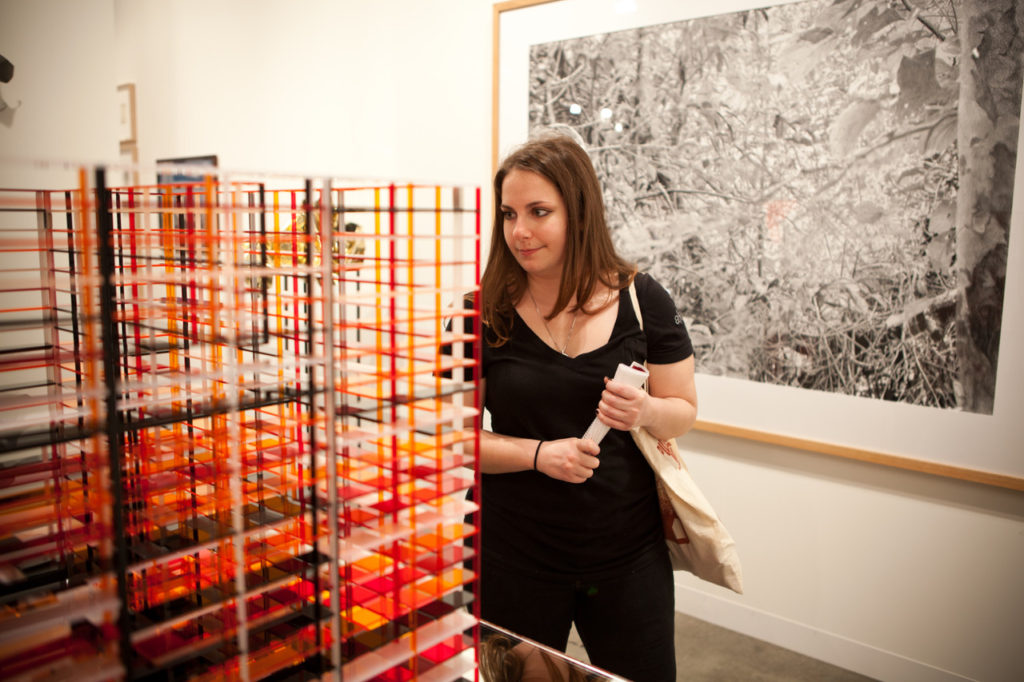Alya Poplawsky & Katy Bakker, AK Art Consulting

What is the purpose of art? Members of the art world have been trying to answer this question since the first art history book was published, but in our line of work, we cannot wax eloquent about this philosophical question. Instead, we must give concrete answers to our clients based on their unique situation.
Case 1: First-time collector, has an excess of money they are looking to invest; from early 40s to recently retired.
For this client, the purpose of art is not purely aesthetic; there must be some sort of bottom line. So, when we are asked by our client what the purpose of art is, we talk about art as an investment. It seems so mundane to relegate art to a commodity, but at the end of the day, not all art collectors and art buyers are sitting in an ivory tower with a purely academic interest in art. Our philosophy when working with clients on “art as investment” is to educate the client on the artist, technique, style, and message, so that they become “invested” in the piece both aesthetically and financially. At this point, we have established the aesthetic value of the work—now, for the financial. When we evaluate a piece for investment potential, the first thing we look at is the artist’s CV. There are certain things we consider: education, solo versus group exhibitions, gallery versus museum exhibitions (and which galleries and museums). We also look into local and international exhibitions, awards and publications, which collections their works are a part of, and even age. Quite frankly, there have been times when we advised a client not to buy a work because a) they were not in love with the aesthetics, or b) the piece was not a sound investment. We have always loved this quote we discovered in a Forbes Magazine article: “My own advice to collectors is this: if you love it, buy it. If you choose well, one day you will be able to sell it for a profit. And if you choose very well, you won’t want to.”

Case 2: Corporate Client
Again, what is the purpose of art? For a corporate client, the purpose of the artwork is to engage a new audience, build and foster ties with the local community, incorporate their branding in a unique way, create a positive work atmosphere, and inspire creativity in their employees. As they buy art for these reasons, they start to create a corporate art collection that could potentially be an influence in the art world. When working with a corporate client, we are working with a committee of people—each trying not to put their own taste into the mix, but failing miserably to stay objective. We are working with design teams, marketing, PR, and executive management. The budget is ever-changing and often unclear, but we have to make sure to understand and stay within the confines of it. Again, educating our client on the artist and the process is key. We have to remind our client that although an artist is willing to do a commission piece, we still have to respect their process and style. The artwork can serve its purpose while remaining true to the artist’s process, aesthetic, and intent.

Case 3: Young, first-time collector in their 20s or 30s
There is a misconception that to collect art, one needs a huge budget or a fancy education. The designation “art collector” can often evoke an image of a stodgy, older, Caucasian male or female dressed in finery of the elite. For some reason, the image of the “art collector” can still tend to be stuck in the 19th century. The reality is, that even if you are not a billionaire social media mogul, you could easily start an art collection if you can put aside $100-200 a month. So, what is the purpose of art for the 20s and 30s crowd? Here we have more room to talk about philosophy and aesthetics. Our clients in this category are looking for a story or a cause. The artist’s message is more important than the technique or investment value. We always say that art is a microcosm for society, documenting the social, political, economic, and cultural changes of the world. Social or political art that documents a certain movement, street art, or a piece that’s just “pretty” are top-sellers to this crowd. A younger collector is willing to take more of a risk, and if the art and artist start doing well, that’s just a bonus.
Upcoming artists are a riskier investment, as their future is unclear, but can be an amazing way to afford works of an emergent star before their prices begin to rise. Think Warhol, who used to practically give his works away to pay for things like bills before he became big—look at how much they sell for, now. Another benefit is that your taste can evolve when you start young, you can educate yourself, and you have years to hone in on the direction you want your collection to go. If you choose well, the artworks will be more valuable later in life, and will represent a personal narrative of your life. You are also establishing yourself in the art world at a young age, becoming familiar with artists and galleries, and ultimately allowing yourself to have a better eye for picking rising stars.

At the end of the day, collectors have the power in today’s art world. They validate an artist’s career, they set pricing, and they determine which artists will make it into the art history books. So, going back to our original question, “What is the purpose of art?” Well, in our line of work, it becomes the reason that artwork goes from being “for sale” to “sold.”
Photos by Patrica Lois Nuss
See more at AKArtConsulting.com
